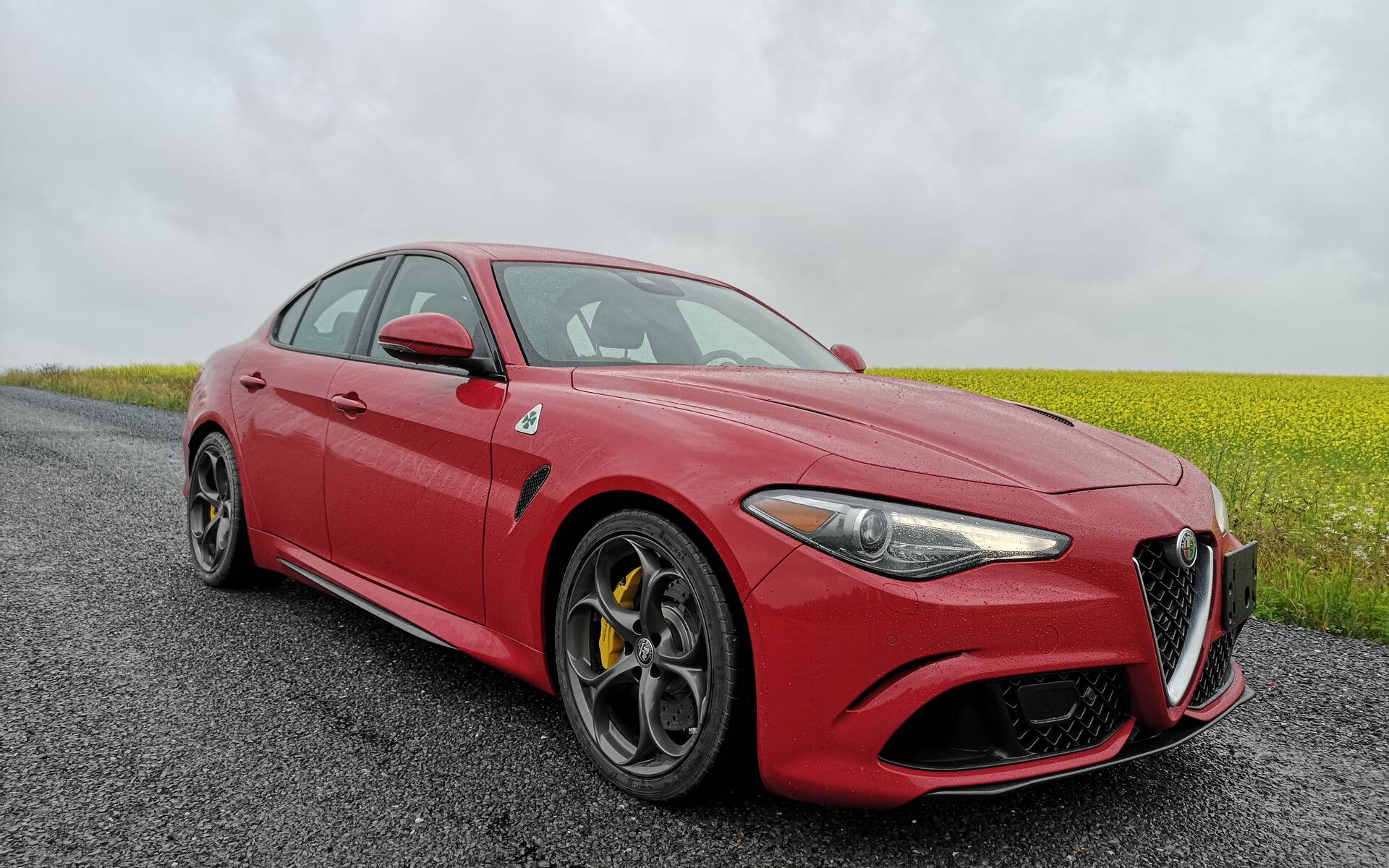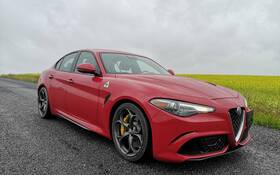2021 Alfa Romeo Giulia Quadrifoglio: Hot-Blooded

| Strong points |
|
|---|---|
| Weak points |
|
One sedan that statistically doesn’t come to mind when shopping for a high-performance vehicle is the Alfa Romeo Giulia. Only 187 units were sold in Canada in 2020, while the most popular members of the segment, such as the BMW 3 Series, pumped out numbers reaching 3,800. But why is this? Price? Reliability? Availability? Obsoleteness? One could think of a few reasons why buyers shun the otherwise very attractive Giulia.
One thing the Giulia doesn’t lack is singularity, which is usually one if not the only symptom related to unpopularity. In addition, it is a beautiful-looking vehicle no matter what angle you look at it from. From an originality standpoint, it constitutes a solid alternative to the effective, yet sometimes anemic BMW, Audi, and Mercedes-Benz sedans that roam the streets by the thousands.
- Also: 2021 Alfa Romeo Giulia, Stelvio Bring Back Sprint Nameplate
- Also: Alfa Romeo Giulia, Stelvio to Receive Key Upgrades for 2020
The Alfa Romeo Giulia is also available in a slew of variants, colour combinations, and two completely different power levels. The Car Guide spent a week covering over 1,500 kilometres of Canadian roadways in Quebec and New Brunswick behind the wheel of the demonic Quadrifolgio variant of Alfa Romeo’s one and only sedan.

The Quadrifoglio has a Prancing Horse Under the Hood (kind of)
What’s under the hood of the Giulia is undeniably it’s most critical selling point: a Ferrari-derived, fire-breathing 505-horsepower engine. The Giulia uses a 2.9-litre twin turbocharged V6 that is qualified as “Ferrari-derived” because it is assembled by a Ferrari technician and resembles the Ferrari V8 (minus two cylinders, of course). An eight-speed automatic gearbox is mated to this Maranello-flavoured powerplant and supplies the engine’s efforts to the rear wheels using a carbon fibre driveshaft.
Alfa Romeo calls its drive mode system DNA. This important facet of the Quadrifolgio allows the driver to select between pre-determined parameters. Dynamic mode is the “sport” mode, Natural mode acts as a “comfort” mode for daily driving, and the Advanced Efficiency mode is, you guessed it, the “eco-friendly” mode, which tries to tone down the attitude of the engine to consume less resources. The Quadrifolgio-specific Race mode also pushes all parameters to their most aggressive. One must use this particular mode wisely, as the tail-happy Giulia could snap and venture into unknown territory.

The Quadrifoglio Puts the Driver First
Once we slammed the right pedal, fury ensued promptly with all horses being channeled to the rear wheels. Operating the gear shifts via a pair of massive paddle shifters mounted to the steering column always feels satisfactory, as the Giula passionately climbs to speeds and never seems to want to give up. This transmission is quick and precise, no matter what mode you use it on.

The close ratio steering and Active Suspension give the Quadrifoglio the cornering attitude it deserves with sharp handling and a firm grip. Coming out of corners, the traction control worked with the differential to allow the Quadrifoglio to slip the rear out just enough to put a grin on our face, while still keeping things in queue. The small, thick steering wheel connected to the wheels makes for a particularly satisfying sport drive regardless of the situation.

Impressive Day-to-Day Capabilities
While one would think that a 500-horsepower, rear-wheel-drive car doesn’t scream daily driver, the Quadrifoglio proved itself daily-able, providing comfort and stability on the open road. Although it carries all this power on tap, the accelerator and transmission are very adaptable for cruising. In the Normal and Advanced Efficiency modes, the suspension adapts to road conditions to provide the driver and passengers with an above-acceptable riding comfort, considering the feisty mentality behind its high-performance sedan character.

When came the time to cool down out ambitions, the Quadrifoglio had the hardware at hand thanks to a powerful Brembo system with six-piston calipers in the front paired to 360mm, co-cast floating ventilated discs, and 4-piston, 350mm in the rear.
A Surprisingly Sober Interior
The interior of the Quadrifoglio doesn’t breathe Gucci or Prada, as one would expect. In fact, it looks more like a Chrysler-derivate that has been dolled up with carbon fibre trim and Alcantara. The comfort level of the seats is more than adequate for hugging curves and long road trips Overall, the Quadrifolgio proved to be pretty comfortable for a sedan of that calibre.

The Giulia’s infotainment system has become more intuitive over the years and is filled with features. However, it can still be a complicated endeavour to achieve some simple tasks – a little cleanup and update would certainly be in order.
Besides the odd tire pressure sensor code, which resolved itself on the road, the Giulia Quadrifoglio proved to be reliable over the 1,500 kilometres it traveled. Although more expensive than its rivals (and maybe less “swanky”), the Giulia, especially the Quadrifolgio, makes heads turn with its uniqueness - both in terms of style and the drive it provides.

Stellantis has announced that Alfa Romeo will become fully electric by 2027. In the meantime, we can still enjoy the passionate amalgam of pistons, carbon fibre and hardware that creates an experience only an Italian car can provide. And that’s another reason to appreciate the Giulia Quadrifoglio; it might not be a logical, value-packed choice, but rather a passionate and ephemeral one.











